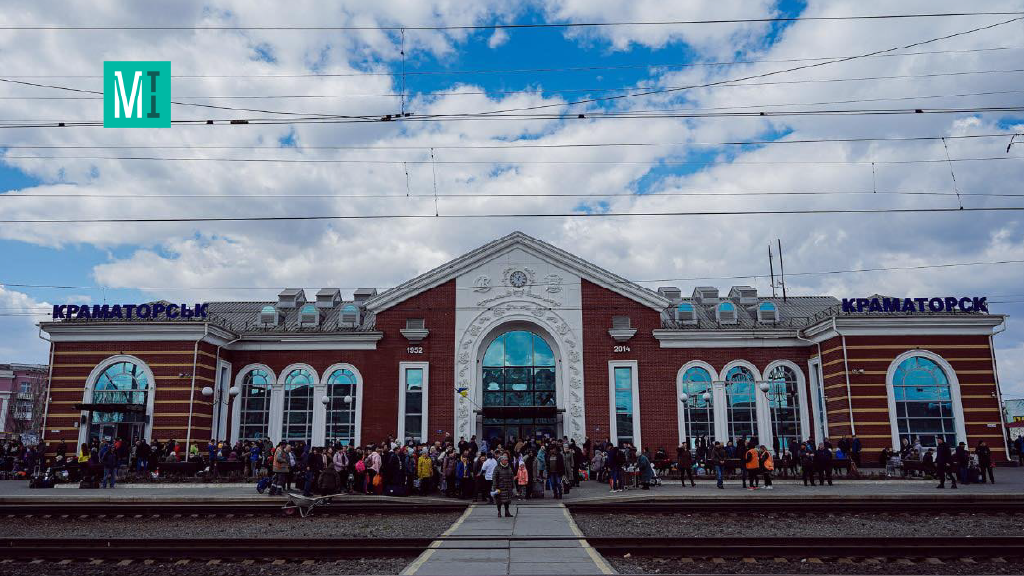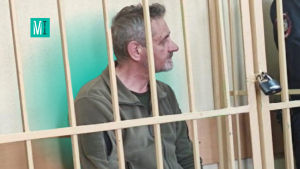Anniversary of the Attack on the Railway Station in Kramatorsk: Will Perpetrators Face Justice?

On April 8 of last year, over 50 lives were tragically lost in Kramatorsk, with almost a hundred more people injured. The MIHR team decided to commemorate this unfortunate anniversary by hearing from witnesses and victims of the missile attack and examining this heinous crime through the lens of international law.
Natalia Stepanenko’s family resided in New York, Ukraine, specifically in Bakhmut district. Tragically, on March 22 of last year, her mother was killed by shelling in the nearby village of Novoselivka. With the subsequent arrival of Russian troops, Natalia made the difficult decision to flee the area. On April 8, 2022, she arrived at the Kramatorsk railway station, accompanied by her ten-year-old twin children and a relative, in the hopes of participating in the authorities’ centralized evacuation efforts for the local population.
“We arrived around 7 am. There were not many people at that time. As time passed, more people arrived, some going inside the station while others remained outside. The entrance to the building was guarded by the police,” Natalia recalls.
Natalia learned from the volunteers on duty that there were four trains scheduled to depart in different directions within Ukraine. To facilitate the evacuation process, the passengers were divided into groups based on their family structure. Families with children under 6 years old were directed to one hall, while those with children aged 6 to 14 were directed to another (Natalia’s family belonged to this group). The remaining passengers were directed to the central hall.
Natalia explains: “My priority was to reach at least Kyiv and from there head to Ivano-Frankivsk. Grandma Tania, who was with us, needed to go to Vinnytsia to visit her sister. Initially, we were all together at the train station, but soon volunteers arrived and informed us that the first train to Khmelnytskyi would depart at 11:55, urging those heading in this direction to proceed to the platform. So my grandmother Tania went to the platform while I remained inside the station with the children.”
Natalia decided to head towards the platform at around 10:30 a.m. and her daughter Yana requested to accompany her, whereas her son Yaroslav stayed behind at the station to watch their belongings.
“There was a tent on the platform where volunteers served tea. Grandma Tanya praised the tea for being delicious and for the candy they gave out. And Yana wanted some. I told her: ‘Get in line’. While she was standing in line for tea, I stepped aside and began chatting with a fellow villager, Maryna, who was there with her husband and daughter. She was pregnant. They had arrived a day earlier and spent the night in the church. As I was talking to Maryna, I glanced over at Yana and noticed that she was third in line for tea. While waiting for her, I gazed out at the city,” Natalia recalls.
It was warm and quiet, but everything changed in a heartbeat
As Iryna Volyanska, a native of Kramatorsk, was walking down the street on the other side of the station at this time. She recalls that the city was in a state of unrest. The sounds of explosions were a constant presence in the outskirts, causing shops to close and people to flee. The previous day, Russian forces had damaged the railway tracks, causing all train services to cease. Those seeking to evacuate were left waiting for the tracks to be repaired, prompting Iryna to make the decision to leave the area as well.
“On that day, an announcement was made that the railway tracks had been repaired, prompting people from different towns and villages to gather in Kramatorsk. I learned from social media that those who wanted to travel by train needed to sign up with volunteers. So I went to the train station to inquire about the evacuation process and sign up for it,” Iryna recalls.
Iryna noticed a large crowd of people waiting to leave in the park on the station square that day. “It was warm, even hot, and I took off my jacket, walking in just a T-shirt. People were sitting on benches, talking, going about their business, moving about town. It seemed like a normal day with a clear sky,” Iryna says.
Everything changed in a heartbeat.
“There was no sound of an incoming missile, no rumbling whatsoever. And then, seemingly out of nowhere, a deafening explosion erupted from above: ‘Boom! Boom! Boom!’ The suddenness of it all was terrifying, with a thunderous rumbling overhead and explosions occurring all around. Glass windows shattered and cars burst into flames. Amidst the chaos, people were running and screaming, seeking shelter in the courtyards of nearby five-story buildings,” recounts Iryna, who took cover behind the nearest kiosk. The barrage of explosions continued relentlessly for what felt like an eternity, lasting up to five minutes.

Territory of the railway station after the shelling. Photo courtesy of the National Police of Ukraine
Although part of the rocket hit the park in the station square, landing 50-70 meters away from Iryna, the railway station itself was hit the hardest.
Daughter said: “Mom, I am dying”
Natalia Stepanenko and her family found themselves in the epicenter of the explosion. She did not realize what had happened right away.
“I was admiring the view of the city when suddenly everything went dark, and my ears started ringing. The next thing I knew, I was lying on the ground, completely disoriented and in shock. I looked around and saw people sprawled out beside me, including Marina and her husband, although their daughter was nowhere in sight. It seemed like everyone was injured and unable to stand. The man who had been serving tea ended up behind the tent. I tried to get up to search for Yana, but to my horror, I realized that my leg was mangled – torn to shreds and barely hanging on by the skin below my knee,” recounts Natalia.

Screenshot from the video recorded after the shelling of the Kramatorsk railway station, courtesy of the Zelenskiy/Official Telegram channel
Natalia saw her daughter Yana two feet away. She was lying on top of grandma Tanya.
“I was violently thrown up into the air from the exact spot where I had been standing. Yana was queued up about one and a half meters behind me, directly behind my back. Grandma Tanya was positioned on the edge of the platform, about 5 to 7 meters away. After the explosion, when I lifted my head, I saw Grandma Tanya’s face mere inches away from mine, with Yanka on top of her. Yanka’s eyes were wide with fear as she cried out, ‘Mom, I’m dying!’ I quickly responded, ‘No, absolutely not!’ She crawled away. I reached out to touch Grandma Tanya and realized that she was already gone, foaming at the mouth. If she had been wounded, I would have expected some signs or moans, but there was nothing. Soon after, police and military personnel arrived and immediately tended to Yana, applying tourniquets to her legs and taking her to safety. Then they bandaged my severely injured legs. One piece of my leg had been torn off at the bottom, and the other was badly crushed,” recalls Natalia.
The woman was taken to a minibus along with other wounded individuals, which then transported them to the hospital.
“The guys carefully placed me between seats, with another woman and man situated at the opposite end. The woman was attempting to lift her head to look at her legs, which were missing from somewhere below the knee. Throughout the journey to the hospital, the young men who were taking us to the hospital repeatedly implored me not to succumb to the darkness and to keep my eyes open. That’s the last thing I recall until waking up in the hospital,” Natalia recounts.
Iryna Volyanska: My first impulse was not to run. Instead, I thought: “Stay. Help will be needed”
Iryna Volyanska recalls that there was no alarm before or during the explosion, and it only sounded after the incident. She explains: “During the explosions, people react differently. I was in a stupor and my first impulse was not to run. Instead, I thought: ‘Stay. Help will be needed’, so I froze in place.”
When the explosions subsided, she came out of her hiding place, only to be met with an utterly shocking sight.
“The scene that unfolded was nothing short of horrific. Blood was everywhere, and numerous people were wounded. There was a decapitated body of a child, burnt cars, and a trolleybus damaged by shrapnel. Amidst the chaos, people were coming together to assist one another, including the police. I saw a man with a wounded arm, so I applied a tourniquet that I retrieved from a bystander, all the while thinking: “I’m going to leave, because I have small children waiting at home and I don’t know what will happen. Maybe it will be even worse,” Iryna recalls. Roughly 10 minutes later, as she was leaving the area, ambulances were arriving at the railway station. Iryna believes that if the missile had detonated directly in the park, the death toll could have been four times as high.

Railway station of Kramatorsk after the shelling. Photo courtesy of the Zelenskiy/Official Telegram channel
The following day, Iryna and her children evacuated Kramatorsk by bus. Upon arriving in Dnipro, she encountered a girl who had been inside the railway station during the missile attack. The girl recounted that the blast had caused the windows to shatter, sending shards of glass flying inside and causing further injuries to those present.
I reunited with my children at a railway station, but this time in Dnipro
Natalia Stepanenko regained consciousness in a hospital located in Pavlohrad, and was shortly afterwards transferred to a hospital in Dnipro. On the fourth day following the tragedy, she received the incredible news that her daughter had survived and was being treated in a children’s hospital located in Dnipro. It was Natalia’s relative who eventually located her and shared the news. A police officer informed Natalia that her son, Yaroslav, was safe and sound. The officer explained that he had initially taken Yaroslav to his own home before eventually reuniting him with Natalia’s family.
“The children each had their own phones, but Yana’s device was knocked out of her hand during the attack. As she crawled away and was just an arm’s length away from me, I was sitting on the ground and noticed her phone and purse lying nearby. Just then, a woman strolled past us, stepped over me, picked up Yana’s phone, and silently continued on her way. I immediately called out to her, causing her to drop the device, which I then retrieved and placed in my pocket. However, once Yana was taken away, she was left without a phone and we were unable to contact her. It was only after some time had passed that a relative was able to locate Yana and provide her with a phone. Since then, Yana and I have been able to stay in touch,” explains Natalia.
In addition to the injuries to her legs, it was discovered in the hospital that Natalia had also sustained damage to her intestine.
“After being transferred to Pavlohrad, I had an Ilizarov apparatus fitted on my leg, but I could not move my toes. I worked in healthcare for 10 years, so I realized that there was no chance of saving my leg. Upon my arrival in Dnipro, the doctor asked me if I was pregnant, to which I replied in the negative. Despite this, my stomach was bloated and I felt nauseous all the time, unable to eat. In Pavlohrad, they suspected that it was a case of stones in the pancreas or bile duct, but upon further examination in Dnipro, it was discovered that a fragment from the explosion had damaged my large intestine. I underwent surgery,” Natalia shares.

Natalia Stepanenko in hospital. Photo by Viktor Kovalchuk
Later, Natalia learned about the tragic fate of her fellow villager, Maryna, whose husband and daughter died on the spot. Despite the efforts of doctors who fought for two days, Maryna, who was 5 months pregnant, also passed away.
A few days later, Natalia was reunited with her children at the train station, but this time in Dnipro. From there, she and her daughter were transferred to Lviv for further treatment. Afterward, the entire family traveled to the United States, where Natalia and Yana are undergoing specialized treatment and rehabilitation to aid their recovery.

Natalia Stepanenko’s family before leaving for the USA. Photo courtesy of the Ministry of Health
According to the acting director of the healthcare department of the Dnipropetrovsk Regional Military Administration, Viktoriya Kulyk, 98 wounded individuals from Kramatorsk were admitted to medical facilities in Dnipropetrovsk Region. The victims suffered from mine-blast wounds to the limbs, spine, and internal organs, as well as concussions and contusions. Six children and seven adults sustained severe and extremely severe injuries. However, most of the wounded were in moderate condition.
Missile launch from the occupied part of Donetsk Region: hypothesis of the law enforcement
According to the Security Service of Ukraine, the shelling of the Kramatorsk railway station on April 8 resulted in the loss of 61 lives, with 121 more people injured. Following a thorough investigation, the Security Service found that the rocket attack had originated from the Donetsk region, which has been under Russian occupation since 2014.
“The attack was carried out using a 9M79-1 guided single-stage solid-fuel rocket equipped with a cluster warhead, commonly referred to as ‘Tochka U’. According to the Security Service of Ukraine, multiple ‘Tochka U’ systems are situated in the occupied regions of Donbas and have been employed by the invading forces for the past eight years. As part of the criminal proceedings under Article 438 (violation of the laws and customs of war) of the Criminal Code of Ukraine, the Security Service is continuously gathering evidence to strengthen their case,” states the Security Service of Ukraine in a statement. Consequently, the incident is being treated as a war crime.

Missile of the Tochka-U system. Photo from the Facebook page of Pavlo Kyrylenko
Halyna Pryshchepa, a spokesperson for the Main Directorate of the Security Service of Ukraine in Donetsk and Luhansk regions, stated in an interview with Ukrinform that the Kramatorsk railway station was hit by enemy missiles on April 8, allegedly fired from occupied Shakhtarsk or Starobeshevo. However, the exact location from which the missiles were fired has not been determined yet.
“The investigation is ongoing, and it is anticipated that it will be a protracted process. It is imperative that we obtain testimony from a militant on the opposing side who can provide a firsthand account of the shelling, the presence of ‘Tochka-U’ at the site, and the subsequent missile launch that struck the railway station. While we can certainly perform examinations and pretrial investigations, we are ultimately reliant on the testimony of specific witnesses to bring this case to a close,” explains the spokeswoman.
Iryna Volyanska, a resident of Kramatorsk, has also provided testimony supporting the hypothesis of shelling originating from the occupied territories. Following the attack, she returned home to collect her belongings before stopping at a store where she overheard a man recounting a sighting of a rocket flying through the sky near Druzhkivka. It is worth noting that Druzhkivka is situated in the same direction as specified in the Security Service report.

Possible missile launch directions from the occupied territory of Donetsk Region. Google Maps screenshot
It is noteworthy that at precisely 10:24 a.m. on April 8, 2022, the Telegram channel “Typical Donetsk” released a video of the launch of two missiles, purportedly from within the occupied town of Shakhtarsk, just 20 minutes before news of the missile attack on the Kramatorsk railway station emerged.

Screenshots from the “Typical Donetsk” Telegram channel

Screenshots from the “Typical Donetsk” Telegram channel
Opinion of international human rights advocates: the missile was launched from Russia-controlled territory
Human Rights Watch (HRW) jointly with SITU Research published the findings of their own investigation into the incident in Kramatorsk.
After carefully analyzing over 200 photographs and videos, as well as conducting numerous witness interviews, the evidence gathered points overwhelmingly to the missile having been launched from Russian-controlled territory located in eastern Ukraine. It has been determined that Russian forces employed a 9M79K-1 ballistic missile, commonly known as “Tochka U”, which was fitted with a cluster warhead.
Ida Sawyer, the Crisis and Conflict Director for HRW, explains that the missile detonated in midair, approximately 2 kilometers above the ground and directly above the railway station, unleashing 50 submunitions, or bombs. These bombs shattered into almost 16,000 small metallic fragments that blanketed a significant area around the station, resulting in the loss of limbs and numerous fatalities.
The experts from Human Rights Watch have identified 32 distinct impact points where submunitions struck the ground, covering an area of roughly 55,000 square meters, equivalent to the size of 10 football fields.
Human Rights Watch has failed to reach a definitive conclusion about the direction of the attack after conducting an analysis of the video footage depicting a rocket launch from Shakhtarsk, Donetsk Region, on April 8. Instead, they posit that the missile may have been launched from near the village of Kunye, situated in Kharkiv Region to the northwest of Kramatorsk, supported by satellite images, local residents’ testimonies, and remnants of the Tochka U missile system discovered on the ground during the inspection of the area after de-occupation.

Possible missile launch direction from Kharkiv Region. Google Maps screenshot
Human rights activists acknowledge that despite the discovery of the possible missile launch site, further investigation is required to determine the precise location of the missile launch site. Nonetheless, Human Rights Watch emphasizes that the attack on the Kramatorsk railway station constitutes a transgression of the laws and customs of war, i.e. a war crime.
Andriy Yakovlev, an expert of the MIHR, managing partner of Umbrella Law Firm, and lawyer of the Regional Center for Human Rights, holds the same opinion.
“Targeting a railway station with indiscriminate weapons during a civilian evacuation is a blatant violation of international humanitarian law and constitutes a clear war crime.
International humanitarian law places limitations on the methods and means of warfare, which includes the prohibition of indiscriminate attacks that do not differentiate between civilian and military targets. The evidence currently available indicates that during the shelling of the railway station, multiple fragments flew in various directions after the explosions, striking civilians and causing injuries. This confirms that the attack was carried out with the use of indiscriminate weapons. The commission of this attack constitutes a severe transgression of the Geneva Conventions and Additional Protocol No. 1 thereto, which constitutes a war crime.
To eliminate any ambiguity, let us scrutinize the attack according to stringent criteria. Firstly, according to international law, only military targets may be attacked. It is worth noting that the definition of a military target is relatively broad and is not limited to locations where military personnel or equipment are stationed. Instead, a military target refers to a target whose destruction can provide a military advantage. Thus, it could be argued that a railway junction, serving both military and civilian purposes, may constitute a dual-use facility.
Secondly, the presence of a military target does not justify the use of force. The feasibility of obtaining a military advantage and the proportionality of the attack must be assessed beforehand. In terms of the latter, it is crucial to determine whether the attack is capable of providing a military advantage. Thirdly, even if such an advantage is attainable, the attack must be executed with the least amount of harm possible to civilians and other objects protected under international humanitarian law. The military advantage resulting from the attack must always outweigh the harm inflicted.
The attack on the railway station in Kramatorsk did not result in any discernible military advantage. Instead, it inflicted severe harm on the civilian population. Therefore, it is evident that the principles of international humanitarian law were disregarded. To obtain a military advantage, an attack must not cause disproportionate harm to non-combatants. Consequently, the attack constitutes a war crime.
Bringing the perpetrators to account is a different matter. It is evident that identifying the individuals directly responsible for launching the missile will be difficult for the Security Service of Ukraine, especially as time passes. Furthermore, the ongoing Russian aggression against Ukraine has exposed weaknesses in Ukrainian legislation. Specifically, the country’s criminal law only provides for personal liability. However, it is doubtful that society will be content with prosecuting only the low-level military personnel directly involved in the missile launch, if they are ever found. Most likely, society expects the highest-ranking members of the occupation forces to be held accountable as well.
The application of the Rome Statute could be helpful in this regard. Specifically, Article 28 of the Rome Statute states that military commanders and other superiors are responsible for crimes committed by forces under their command and control. This would not only enable the prosecution of high-ranking officials but also expedite the conclusion of the case since it is easier to identify responsible military commanders who allowed or caused the war crime due to inadequate control than to locate the individuals who launched the missile. However, Ukraine has not yet ratified the Rome Statute, which could hinder the investigation of war crimes and the prosecution of perpetrators. To illustrate, the situation involving the widely publicized arrest warrant for Putin was based on Article 28 of the Rome Statute.”
P.S. At the time of this writing, the MIHR had requested the Security Service of Ukraine for updates on the progress of the investigation into the rocket attack on the railway station in Kramatorsk, but had not received any response at the time of publication.

Lidia Tarash, MIHR journalist








